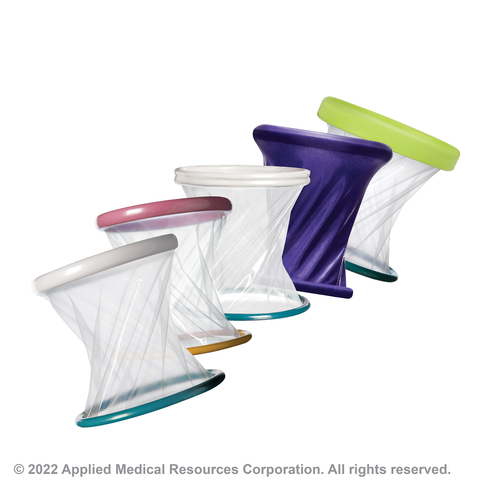RANCHO SANTA MARGARITA, Calif.– Applied Medical is commemorating 20 years of wound protection since the first Alexis wound protector-retractor was introduced. The Alexis brand is recognized worldwide for improving patient outcomes and reducing superficial surgical site infection. Over the last two decades, Alexis devices have protected 17 million wounds in more than 75 countries. The devices have also expanded into a full-line of protector-retractors designed to meet a variety of surgeon and patient needs.
Alexis devices are the protector of choice in a wide array of surgical specialties, including general, thoracic, colorectal, obstetric and gynecologic, among others. The devices are used in both open and laparoscopic procedures, and when combined with Applied Medical’s unique GelSeal® technology, they help enable hand access, reduced port, and single port laparoscopic surgery, and scarless natural orifice approaches. The Alexis product family also includes protectors specifically designed for orthopaedic procedures and cesarean section deliveries.
Innovation is at the heart of the Alexis brand. Applied Medical continues to expand its offerings and recently extended the Alexis protector-retractor line to include a larger size, XXXL, which accommodates incisions ranging from 25 to 32 centimeters. Also this year, the design of the Alexis contained extraction system was enhanced, including an expanded indication for use to allow more patients to benefit from this technology and surgical approach.
“At Applied Medical, we continually innovate and improve upon the designs of even our most widely used products to better meet the evolving needs of healthcare,” said Serene Wachli, group president of the Horizon II Division at Applied Medical. “Our Alexis protectors and systems are as surgically versatile as they are vital to improving patient outcomes. We’re proud to celebrate 20 years of protecting wounds with our Alexis solutions, truly marking our sustained commitment to infection prevention and reducing the cost of healthcare.”
The benefits of Alexis wound protectors have been documented in dozens of clinical studies which validate their efficacy. Surgeons around the world depend upon Alexis devices to protect their patients from wound infections, while providing circumferential, hands-free incision retraction.
“I was an early adopter of the Alexis protector and have incorporated the device into nearly every open surgery I do,” said Joe Sharma, MD, Emory University School of Medicine. “Beyond the essential benefit of reducing infection, using an Alexis protector improves exposure and visualization during surgery, and helps the incision heal faster for my patients. Alexis devices became a significant part of our quality improvement around surgical site infection.”
There is extensive clinical evidence that Alexis-branded devices improve patient outcomes by reducing superficial and deep incisional surgical site infections,1, 2, 3, 4, 5 offer unparalleled exposure without the trauma and pain associated with prolonged point retraction,5 shield the incision site from bacterial invasion,6, 7 create a tamponade effect to minimize blood loss,5 and maintain moisture at the incision site to promote healing.5, 8, 9
|
1 Reid K, Pockney P, Draganic B, Smith SR. Barrier wound protection decreases surgical site infection in open elective colorectal surgery: A randomized clinical trial. Dis Colon Rectum. 2010;53(10):1374-1380. (Level of Evidence 1) |
|
2 Cheng KP, Roslani AC, Sehha N, et al. ALEXIS O-Ring wound retractor vs conventional wound protection for the prevention of surgical site infections in colorectal resections. Colorectal Dis. 2012;14(6):e346-e351. (Level of Evidence 1) |
|
3 Lee P, Waxman K, Taylor B, Yim S. Use of wound-protection system and postoperative wound-infection rates in open appendectomy: A randomized prospective trial. Arch Surg. 2009;144(9):872- 875. (Level of Evidence 1) |
|
4 Horiuchi T, Tanishima H, Tamagawa K, et al. Randomized, controlled investigation of the anti-infective properties of the Alexis retractor/protector of incision sites. J Trauma. 2007;62(1):212-215. (Level of Evidence 1) |
|
5 Hinkson L, Siedentopf J-P, Weichert A, Henrich W. Surgical site infection in cesarean sections with the use of a plastic sheath wound retractor compared to the traditional self-retaining metal retractor. Eur J Obstet Gynecol Reprod Biol. 2016;203:232-238. (Level of Evidence 1) |
|
6 Mohan HM, McDermott S, Fenelon L, et al; Members of the University College Dublin Wound Retractor Study Group. Plastic wound retractors as bacteriological barriers in gastrointestinal surgery: A prospective multi-institutional trial. J Hosp Infect. 2012;81(2):109-113. (Level of Evidence 2) |
|
7 Horiuchi T, Tanishima H, Tamagawa K, et al. A wound protector shields incision sites from bacterial invasion. Surg Infect (Larchmt). 2010;11(6):501-503. (Level of Evidence 4) |
|
8 Ousey K, Cutting KF, Rogers AA, Rippon MG. The importance of hydration in wound healing; reinvigorating the clinical perspective. Journal of Wound Care. 2016;25(3): 124-130. |
|
9 Horiuchi T, Nakatsuka S, Tanishima H, et al. A wound retractor/protector can prevent infection by keeping tissue moist and preventing tissue damage at incision sites. Helix Review Series: Infectious Diseases. 2007;(3):17-23. (Level of Evidence 5) |



